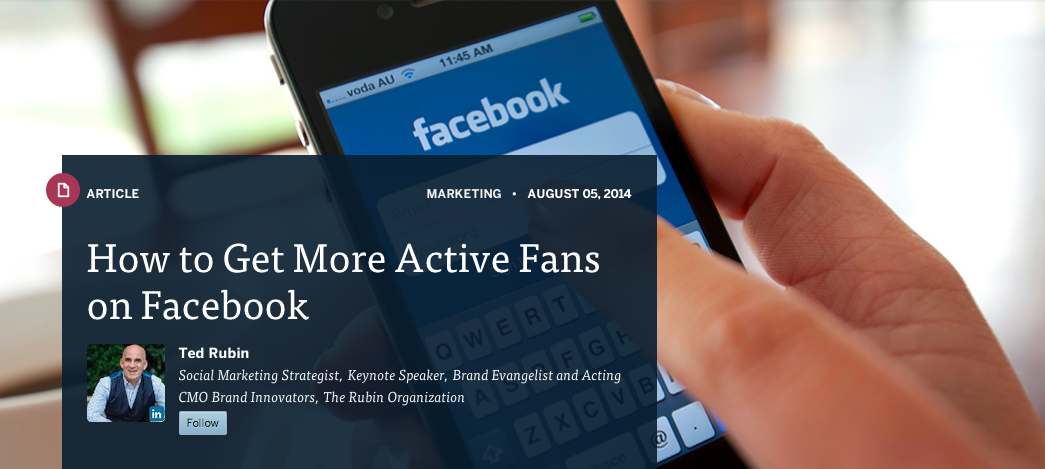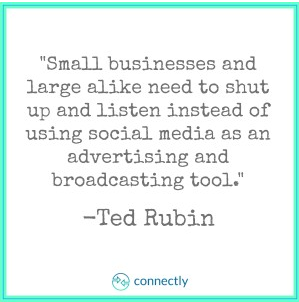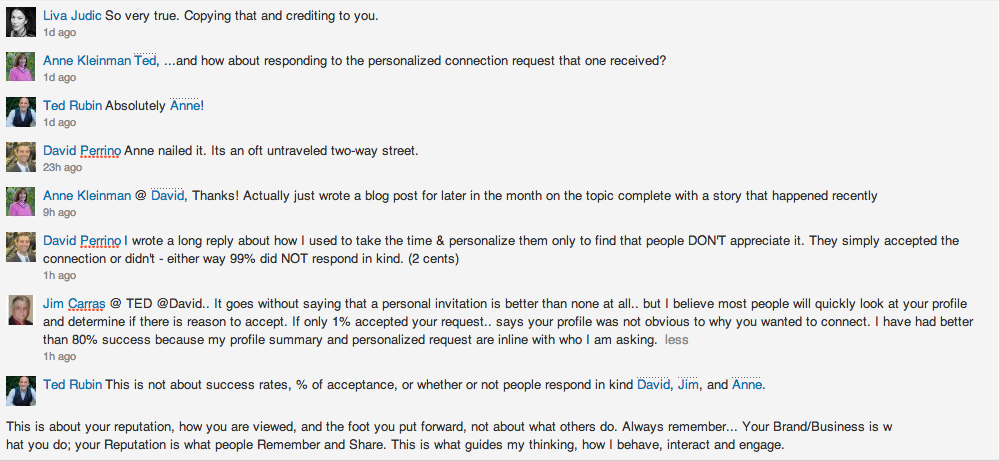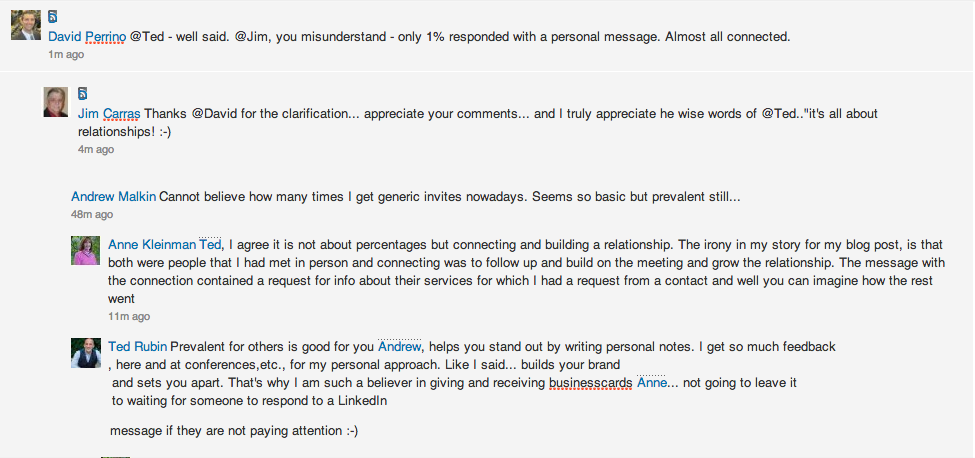—–“Want to turn “lurkers” into active participants on your Facebook page? Learn what it takes to really connect with your Facebook visitors.”
Small Businesses and Large Alike Need to…
Small businesses and large alike need to shut up and listen instead of using social media as an advertising and broadcasting tool.
They are too worried about who has more Twitter followers and about who has more fans on Facebook. They’re worried about who is getting the message out more consistently on those platforms rather than taking the amazing amount of market intelligence available to them by looking at people that are following them and reading what they are writing on their own pages.
Businesses need to spend less time tweeting and posting to Facebook, and more time reading, listening and understanding what it is their customers really want. They can’t expect to use social media only when it is convenient for them and expect customers to remain engaged.
Way too few companies are empowering their employees on social media, seeing it as a threat instead of a benefit. Small business needs to recognize that their best advocates are their employees. Empower your employees and they will power your brand.
Important Advice for Reaching Out via LinkedIn and Facebook
A little advice for people here using LinkedIn and Facebook, more of a very strong suggestion… stop sending out invites without a personalized note, and best if that note offers a reason you want to connect.
Just saying people… it’s all about building relationships, not just being connected, and the first step of that relationship is the introduction… especially if we have never met!
4 Social Media Platforms to Empower Your Employees
Who knows your business as well (if not better) than you do? The people who work in your business, of course! And I’m not talking about a sales staff. I’m talking about your nuts-and-bolts employees who know the everyday ins and outs, whether they work with your customers, handle inventory or do the behind-the-scenes work that helps run your company. In today’s socially-connected world, employees are often an untapped resource that (with a little guidance) could exponentially expand your company’s word-of-mouth reach. Empower them so they can power your business.
Your employees can use these four social platforms to help spread the word about your company:
1. LinkedIn
Especially if your company is B2B, have a company profile on LinkedIn, and encourage all employees to have personal profiles that link them to your company. Each person has talents and skills they contribute to your business that could be highlighted with your company’s keywords in each employee’s summary and experience areas. LinkedIn Recommendations can also increase your company’s visibility in the channel.
Ask employees to join groups where they can share their insights and answer questions.
2. Facebook
If you have a business page on Facebook, have employees link to it in the “About” section of their profiles. Also, set up a private group where your employees can collaborate. Seek out groups that fit your company niche and encourage employees to join; not to SPAM others with your messaging, but to find ways to contribute, answer questions, share expertise, etc.
3. Twitter
Twitter is a great place to provide an extra level of customer service that goes beyond your own company brand on Twitter. People-to-people interaction gives your brand a more human touch. Each person can actively “listen” for company mentions, questions and conversation around keywords and jump into the conversation where appropriate—even if it’s just to thank someone for mentioning or Retweeting your brand. Encourage employees to share Tweets around your company’s activities and content. Come up with a company hashtag or a series of hashtags (e.g. #companyname, #companyevent) and pre-craft Tweets to make it easy. They can just cut and paste to share on their Twitter feed.
4. Instagram
Even if you don’t have a photogenic product, your employees with smartphones can still spread positive messaging about your company with Instagram. From photos of the lunchroom, to customer gatherings to company events, there are many ways your employees can pull in prospects with images.
Hashtags can now be used and tracked on all four of these platforms.
A little encouragement goes a long way!
Set some formal guidelines, keeping in mind that if you clamp down too hard, employees may back away from participating. Offer in-house social training, led by your best in-house and local experts. Provide incentive programs to reward the employees who provide the most relevant ideas and responses.
Remember that your employees are your company’s best resource—make the most of their passion and individuality. They’re already social, so start thinking of how you can empower your employees to have their own voice, and you will discover many can and will become your company’s most active and valuable social advocates.
Originally published October 2, 2013 at salesforce Blog
Ted Rubin shares, with @newscomauHQ’s @ClaireRPorter, the top 10 things businesses are getting wrong on social media
BUSINESSES should stop tweeting so much and shut up and listen to what their followers are saying about their brands on social media, according to Ted Rubin, Chief Marketing Officer of social media company Collective Bias.
And he would know. Of all the CMOs in the world, Ted has the most Twitter followers.
Give your Brand a “Personality Test”
Have you given your brand a “personality test” lately? When you think of big brands that stand out, what comes to mind—just their product, or how their communications make you feel about them? It used to be that mass advertising was the way brands developed a personality, but that’s no longer the case. With today’s social communications being so important to a brand’s reputation and perception in the marketplace, finding a way to involve your friends and followers in building that personality is essential.
I’ll give you a few good big-brand examples (personal disclaimer… Duane Reade and Mastercard are Collective Bias clients).
The Real Value Of A Facebook Like
Trying to qualify the value of a Facebook Like for a given brand has been shown to be an incredibly elusive and often frustrating exercise. An exercise many brand managers and marketing managers would say ends more often than not, in futility.
Sure, having that large number of Facebook Likes is always great for the ego while standing around the water cooler with the brand managers and marketers – but what is the inherent value?
What good are all these Likes if it doesn’t correlate to increased revenue?
Two recent studies have shed some light on what the value of a Facebook Like truly is: “The Facebook Factor” via Forrester and the “Power of a Like 2” the sequel to comScore’s “Power of a Like” released last year.
Pinterest Rivals Twitter in Referral Traffic
 To those of you who lead “the Pinteresting life,” you’ve contributed to a phenomenon that is certainly putting its clicks where the hype is. By that I mean, Pinterest is a two-year old cultural sensation that is borderline causing dependency among its users and the rabid audiences they’re developed. This rapid fire network has pinned itself to a rocket with estimated unique viewership ascending 429% from September to December 2011…and I’m not even sure if the sky’s the limit here.
To those of you who lead “the Pinteresting life,” you’ve contributed to a phenomenon that is certainly putting its clicks where the hype is. By that I mean, Pinterest is a two-year old cultural sensation that is borderline causing dependency among its users and the rabid audiences they’re developed. This rapid fire network has pinned itself to a rocket with estimated unique viewership ascending 429% from September to December 2011…and I’m not even sure if the sky’s the limit here.
For those who are unfamiliar with the fledgling community, Pinterest is a effective marriage of social bookmarking and visual curation with an extremely fervent user base.
Do you call on those Raising their Hands?
 Every Google search is a hand being raised. So is every tweet, blog post, and Facebook comment with a complaint or question. Do you call on those raising their hands?? If not, you are missing an incredible opportunity!
Every Google search is a hand being raised. So is every tweet, blog post, and Facebook comment with a complaint or question. Do you call on those raising their hands?? If not, you are missing an incredible opportunity!
Every social complaint or question is the “low hanging fruit” of a brand’s chance to interact with consumers. But it’s not just ANY chance – it’s a chance to interact when you have the consumers full attention “and” PUBLICLY, to engage in a way that can, and often will, catch the attention of an entire audience. These kinds of comments are visible, relevant and actionable, and brands need to have a plan to engage.
To Link or Not to Link Social Media Accounts?
 One of my LinkedIn connections (Phil Masiello) recently asked me an important question – one that, in my opinion, everyone should be asking themselves if they haven’t already. Following is his question, with my response and a few additional thoughts:
One of my LinkedIn connections (Phil Masiello) recently asked me an important question – one that, in my opinion, everyone should be asking themselves if they haven’t already. Following is his question, with my response and a few additional thoughts:
Phil: Ted, I have my Twitter linked to my LinkedIn account. One of my contacts is complaining to me that I shouldn’t do that. Linked in is for business and Facebook is for other. My twitter is mostly related to business, business travel, etc. What is your thought? Should I take twitter off LinkedIn?
My response went something like this:
I connect my Twitter activity to my Linkedin account because I do very little daily LinkedIn interaction and this way my LinkedIn presence still has a life. I DO NOT connect Twitter to Facebook since those posts do fill up peoples pages and cause issues, and the language I use for Twitter and Facebook differs so greatly.
I have had a few LinkedIn complaints as well (about showing my Twitter activity there), but those complaints are HUGELY outweighed by the positive feedback and interaction it creates for me in a medium that lacks that easy functionality. I explain this to those who complain, and they all understand my reasoning. That being said, if they are unhappy, they can simply unlink from me, with no harm done.
I DO pay attention to these things and if the negative begins to outweigh the positive, I will change my practice.
The key things to ask before linking any social media streams are:
- Is the information relevant to more than one network? If not, don’t link.
- Is the language (tone, formal vs. informal, etc) appropriate for more than one network? If not, don’t link.
- Is the content valuable to more than one network? If not, don’t link.
- Is the content appropriate for the purpose of more than one network/tool? If not, don’t link.
- Is the link (and resulting automatic feed) likely to get in the way of other people’s online experience? If so, don’t link.
Although each social media tool has several shared attributes, each tool also has different functionality and different purpose – which draws a different audience and content for each.
Bottom line? Pay attention to your audience and make sure your links between tools are of value to each audience involved, and not just an easy (but useless) way for you to spray your content far and wide. Just because you CAN doesn’t mean you SHOULD.
On the other hand, when done intentionally and appropriately, linking content feeds from one social media tool to another can be a highly effective and valuable way to extend your online presence to more than one relevant audience in more than one way.
Bottom line? It’s your choice… just choose wisely, for the sake of all involved.
Ted Rubin
PS. Notice how Phil used social media to request information from a trusted source. LOVE it!
Originally posted at Zemoga’s FromBogotaWithLove.com







